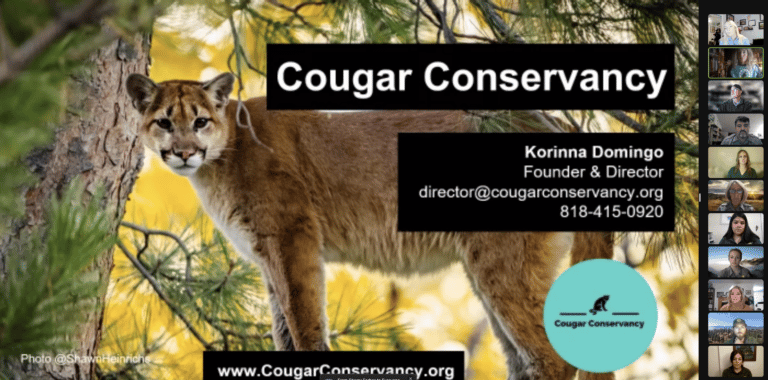
On Wednesday, Nov. 9, a cougar attacked a small dog while it was being walked on a leash near the Hollywood Reservoir. Based on video footage and GPS tracking collar data, Santa Monica Mountains National Parks Service confirmed P-22 was the animal responsible for the attack.
“We understand an incident like this is upsetting and can possibly heighten people’s concern for the safety of their pets and themselves. We also want to express our sympathies to the dog owner,” Santa Monica Mountains National Parks Service shared on Instagram. “As many of you know, the NPS has been studying generations of mountain lions in this region, including P-22, for more than 20 years. While the California Deparment of Fish and Wildlife manages these animals in our state, we are committed to learning as much as we can about them through our scientific research, with the goal of conserving mountain lions in the park. It is our mandate to preserve all of the wildlife in the park for future generations.”
In terms of the incident, specialists said there is no evidence that preying on pets is related to an increased chance of an attack on a person, either in mountain lions, or in other urban carnivores such as coyotes. Specialists said mountain lion attacks on humans are exceedingly rare.
Mountain lions are typically more active during dusk and dawn and an hour after sunset, and the incident occured in full darkness.
While mountain lions largely avoid urban areas and are fearful of humans, they sometimes travel through residential areas near their preferred habitat. According to the video footage of the incident, P-22 did not attack the dog walker or show any aggressive behavior toward him.
The National Wildlife Federation California and a team of biologists and Cougar Conservancy members hosted a “Coexisting With Cougars” seminar on Monday, Nov. 21, to educate residents on the recent mountain lion attacks.
Regional Executive Director of the National Wildlife Federation Beth Pratt led the seminar and introduced the group speakers.
“We don’t want incidents like that to happen, they are rare, it is never zero risk wildlife, these are wild animals,” Pratt said. “But like preventing crime, with wildlife we can also do things to minimize that risk and get it as close to zero as possible.”
Pratt said P–22 and other mountain lions that prey on animals are not abnormal as it resembles their natural prey.
“There was no sign of aggression towards the dog walker,” Pratt said. “There was no evidence that mountain lions or coyotes or other wildlife when they do attack livestock or domestic animals that it signals any increased threat to humans.”
Most recently, on Friday, Dec. 2, a 2-year-old girl was attacked by a coyote in Woodland Hills. Her father, Ariel Eliyahuo, was able to run to her side and save her from the coyote.
Eliyahuo said they wouldn’t expect to see coyotes in their neighborhood. Authorities said there were a few coyote sightings in the area Saturday night.
For the presentation, founder and Cougar Conservancy Director Korinna Domingo, provided safety tips for recreationists and those who live in urban areas.
Domingo provided information on their cougar conflict task force and conflict prevention which conducts work on the ground to intervene, directly assist and empower local communities through training and education before and after cougar conflict occurs.
A family in the Santa Ana Mountains reached out for a conflict prevention visit for their 4-H animals after hearing incidents occurring with neighbors who own or house livestock.
“The service really allows individuals the opportunity to be proactive as opposed to reactive to human-wildlife interactions,” Domingo said.
Cougar Conservancy offers assistance programs in pen building, carcass disposal, and trail camera rental programs to reduce barriers.
Domingo said they also offer workshops to inform those on the basics of conflict theory and hands-on training sessions that focus on practical mitigation tools.
Regarding keeping your animals safe, Domingo said proofing your barns and animal housing with walls, fences, and a roof at night is the best preventive measure to keep animals safe.
“The main message when building an enclosure is that any gaps more than four inches need to be closed off,” Domingo said.
Domingo suggested another way to reduce conflicts with predators is by trimming vegetation above the ground by 2 to 3 inches. Landscaping can reduce the areas where cougars and other wildlife can take refuge. Trimming hedges and reducing backyard clutter can also minimize wildfire risk.
Securing trash and compost piles can also prevent the activity of wildlife. Cougars may not raid your trash bins, but unsecured trash and compost piles often attract rodents and predators that prey on them.
To report a cougar sighting, individuals can send videos to SAMO_mountainlions@nps.gov or call (805) 370-2317.
While hiking with friends or alone, Domingo provided tips on trail safety, such as staying on marked trails, hiking in groups, supervising children at all times, and considering carrying an air horn or bear spray.
Domingo provided tips on what to do when encountering a cougar, such as making yourself look as large as possible by extending your arms or opening your jacket. Domingo said if you are hiking with your pet, pick up small dogs, bring them as close as possible, and hold them firmly on a leash beside you.
Domingo wrapped up the presentation with more resources and information on the Cougar Conservancy organization.
“With mountain lions attacks are very very rare, in the last 100 years in California with 40 million people, there had been 22 attacks with six that were fatal in California, we never want an attack to happen and those are people not just statistics, but what we just say is put the risk in perspective,” Pratt said. “Your chances of being attacked by a mountain lion are not zero but are very low.”
To watch the seminar visit, https://www.youtube.com/watch?v=0gBj3tLTixE